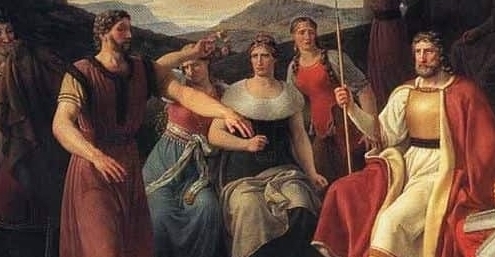
An Understanding of the role of Loki in Odinic Mythology
Deities & Lore, OR and OdinismBy Heimgest DCG
In the myths, the figure of Loki is present throughout the cycle and is only vanquished at Ragnarok. Viewing the myths on the level of our own personal evolution and self realisation, the Ragnarok is representative of our final overcoming of that which stands in our way to attaining that higher evolution, so we see that it is only by overcoming that “enemy” that we are successful in that.
In the myths, the figure of Loki is present throughout the cycle and is only vanquished at Ragnarok. Viewing the myths on the level of our own personal evolution and self realisation, the Ragnarok is representative of our final overcoming of that which stands in our way to attaining that higher evolution, so we see that it is only by overcoming that “enemy” that we are successful in that.

The Origins of The Stork and Newborns
Deities & LoreBy Gothi Arinbjorn OR
To those who follow the path of the ancient Northern Europeans, the spirit of man is eternal and immortal, living a number of lives as works towards enlightenment, what we call the Odic Consciousness.

Meditations on the Black Sun – Part 1
Deities & LoreBy Volksieg AOR
The sole intention of this piece is to provide food for thought and, perhaps, to act as a launch pad for further discussion and exploration. None of the writings below should, of course, be considered “Holy Writ” or any such dogmatic nonsense but should be treated as they truly are: mere threads of thought collected as they became apparent. Therefore, I leave it up to you, dear reader, to ascribe any objective value of truth as is deemed necessary.

Getting to know your Fetch
Deities & LoreBy Volksieg AOR
The Fetch, as many of you may know, is an entity who is with you, throughout all your incarnations, acting as a guide to greater spiritual development and, when the relationship between Odinist and Fetch is fully developed, it is entirely possible that it can act as a protector in this realm also.

Yggdrasil – Interconnections and Dependency
Deities & LoreBy Ulfhethnar Odinsen AOR
The tree is a common motif in our sacred mythology as well as in that of various cultures world-wide. Yet nowhere does it seem to have left such an indelible mark as it has in the Nordic cultures of Europe. From the mighty ash tree Yggdrasil to our progenitors Askr and Embla, the Ash and Elm.

Comparison between the Sleeping Beauty tale and some Norse myths
Deities & Lore, Poetry & ProseBy Hariulf OR
As many of you know, there is much wisdom in fairy tales. We find preserved in children's literature traces of old Indo-European myths. This is particularly true in The Brothers Grimm's fairy tales. Wilhelm Grimm said himself: "the elements found in all fairy-tales are like fragments of a broken stone that we have scattered on the floor, amid the grass and flowers: only the most piercing eyes can discover them. Their meaning is long lost, but we feel it again and this is what gives the tale its value. "

Runic Name Analysis: Living up to your name
Runesby Shawn E AOR
I have found that using the runes to analyze and interpret various aspect of people's names is an interesting exercise in growing in personal runic understanding. It has also been rather fruitful in helping others see themselves in a new light.

John Barleycorn Must Die
Deities & Lore, Poetry & ProseBy Reginhard OR
John Barleycorn is a character in English folksong and is a personification of barley and more importantly of the beer made from it. In the song he is subjected to a number of assaults which correspond to the harvest milling and brewing of beer. John Barleycorn encounters great suffering and death so that others may benefit.

A War Of Words And Wit: A Literary Analysis Of The Hárbarðsljóð
Deities & Lore, Poetry & Proseby Casey AOR
Contrary to mainstream belief of Old Norse culture, intelligence was a highly valued characteristic of men, sometimes even more so than strength and power. Therefore, it is no surprise that the chief god of the Norse, Odin, disguised here as the ferryman Harbarth, is the patron of not only warriors but also the wise.

The Runic Era: Some History of the New Awakening
OR and Odinism, RunesBy Heimgest DCG
We receive many enquiries about OR practices and questions/misunderstandings about the Runic Era are not rare. Here then are the facts.

Winter Nights and the Healing of the Soul
Blot and Ritual, Deities & Loreby Hyndla OR
For the past 10 years, Donar’s Hearth and the Odinic Rite Vinland have hosted a Winter Night’s party that was open to the “public”. We have always combined the spiritual with the fun. We have the traditional games of…

Wights and Our Folkway
Deities & Lore, Family & Societyby Juliegh Howard- Hobson AOR
The care and keeping of landwight relations is underemphasized in the many writings on Northern European folkways. Yet, it is the wights, (disir, alfar, house wights, land wights, tompts) who actively strengthen—even more than our ancestors, and more than our gods--our vital link, our holy bond, to Nerthus, the earth, this place we occupy day and night until we leave.
